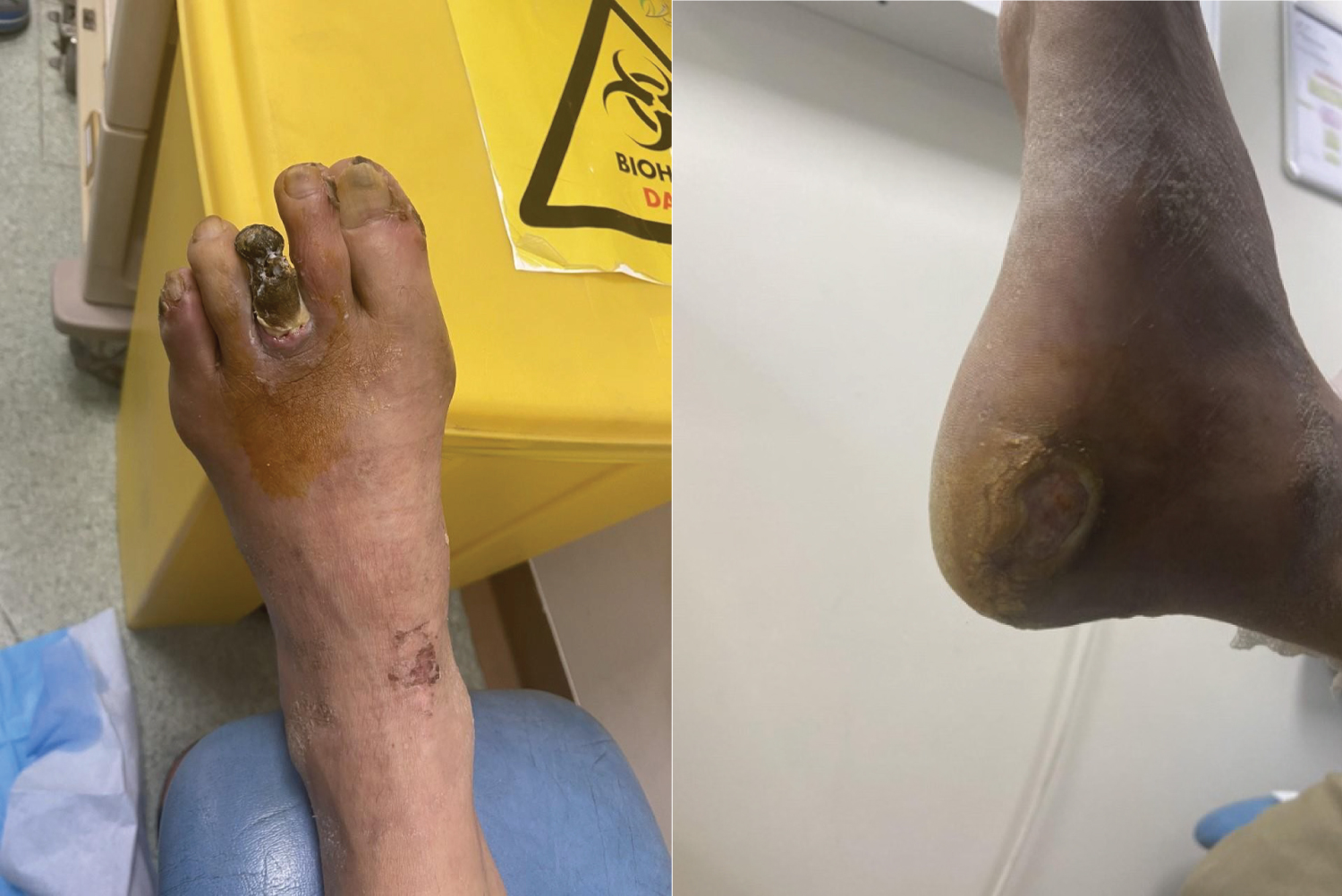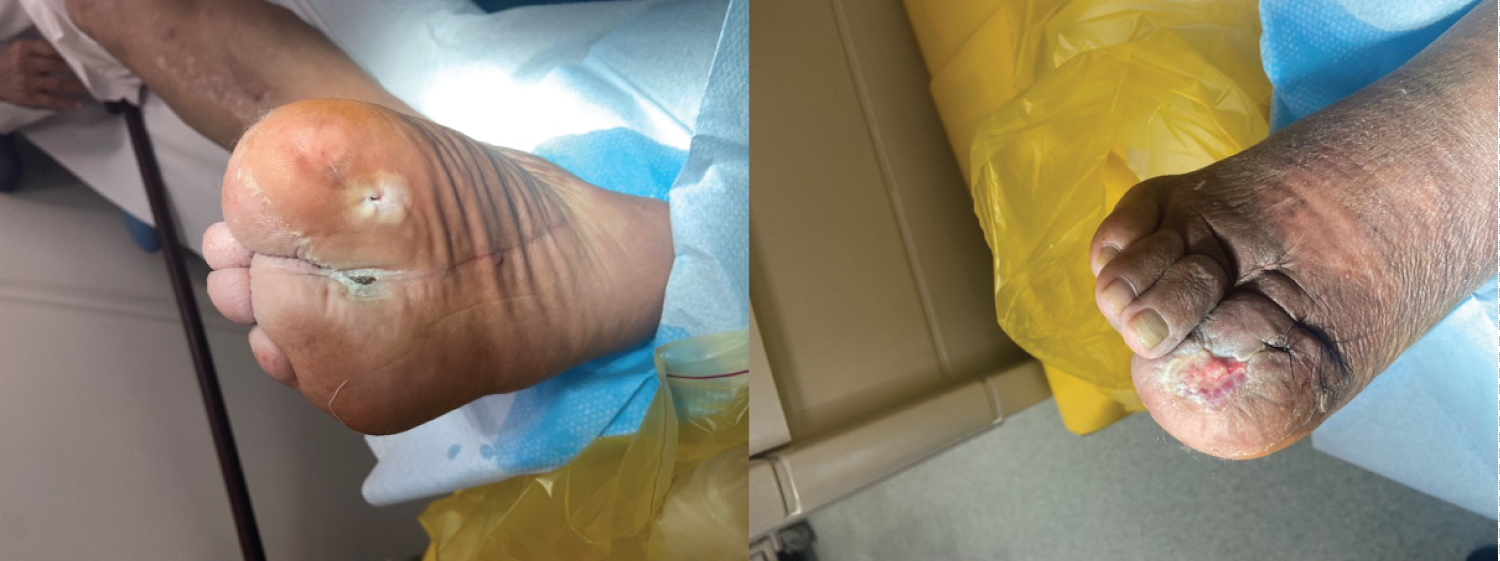Research suggests that comorbid diabetes and depression is common. Diabetic foot ulcers and lower extremity amputation are unfortunately severe complications of diabetes which can have a serious negative impact on the quality of life in diabetics. Elderly may even have more significant impairment on their daily life because of chronic pain and immobility. A literature search on diabetic foot and geriatric depression showed that limited studies and case reports have addressed this issue.
We report two cases of comorbid diabetic foot ulcers and depression in elderly patients to highlight the clinical impact of their quality of life. The first case is a 67-years-old gentleman known case of diabetes mellitus type 2 and comorbid anxiety and depressive illnesses. We showed how his mental illness has impacted on his ability to be adherent to diabetic care. The second case is a 77-years-old gentleman who developed severe depression secondary to diabetic complications.
We advise a multidisciplinary approach, involving the general practitioner, psychiatrist, and psychologist, in the management of diabetic patients with foot ulcers in order to optimize wound healing and patients' quality of life.
Depression, Diabetes complications, Geriatric psychiatry
Diabetes mellitus (DM) is a chronic, metabolic disease characterized by elevated levels of blood sugar (fasting more than 7 mmol/l), which leads over time to serious damage to the heart, blood vessels, eyes, kidneys and nerves [1]. Diabetic foot ulcer (DFU) is one of its major complications that needs a multidisciplinary approach [2]. Diabetic patients have psychiatric symptoms such as depression more frequently than the general population [3]. A Pubmed search for "diabetic foot AND (mental health OR mental illness OR psychiatry)" on 25th October 2021 identified 248 items items addressing this issue, including 22 case reports/series. Out of these, only one report highlighted the case of a 57-years-old white male with chronic diabetic foot and depression who committed suicide with an intentional insulin overdose [4].
Depressive symptoms have been found more prevalent among diabetic foot patients as compared to non-diabetic patients [5]. It was found that insulin receptors were distributed throughout the brain, including classical regions with regard to mood regulation [6]. Lyra, et al. [6] also emphasized a possible role of decreased brain insulin signaling due to metabolic disorders in the related mechanisms of depressive symptoms [6]. During follow-up, Pedras, et al. [7] found that depression may make foot ulcers larger and more severe [7]. Foot problems are significantly associated with mental health symptoms in diabetic patients and caregivers [8]. This may affect treatment in the foot clinic, outcome, and quality of life.
The patient is a 67-years-old gentleman with a past medical history of Diabetes Mellitus Type II for the past 15 years. He is on oral hypoglycemic drug -Metformin 1000 mg - Sitagliptin 50 mg XL twice daily and Gliclazide 120 mg XL daily. However, he has a poor compliance to his medications as demonstrated from his medication refill history which shows that he did not resupply his drugs for the past 6 months. He is also a known case of anxiety and depression for which he is taking Escitalopram 10 mg and Risperidone 2 mg once daily. Nonetheless he has a poor compliance to his psychiatric appointments and poor adherence to his medications.
He lives with his family and smokes two packs per day but does not drink alcohol or use recreational products. He did not attend his three-month routine appointments at the diabetic clinic, nor performed his regular blood investigations (HbA1c, renal and liver function tests). Table 1 shows the patient's pertinent laboratory findings. The patient has no record of neither diabetes retinal screening nor regular foot care treatment March 2021 attended the health center for diabetic foot wound dressing care and review. Upon examination both feet had signs of advanced diabetic foot complications such as no arterial perfusion, absent dorsalis pedis and loss of vibration and touch sensation (Figure 1).
 Figure 1: Shows gangrenous third toe with auto-amputation and combined diabetic neuropathic and ischemic ulcer.
View Figure 1
Figure 1: Shows gangrenous third toe with auto-amputation and combined diabetic neuropathic and ischemic ulcer.
View Figure 1
Table 1: Shows pertinent laboratory findings of Case 1. View Table 1
The patient is a 77-years-old gentleman with a past medical history of Diabetes Mellitus for more than 20 years, in addition to ischemic heart disease, heart failure and dyslipidemia. His daily medications consist of vildagliptin 50 mg- Metformin 500 mg twice daily, dapagliflozin 10 mg, insulin glargine 55 Units nocte, aspirin 100 mg, carvedilol 6.25 mg twice daily, rosuvastatin 10 mg nocte, and pantoprazole 40 mg. He lives with his family and is neither a non-smoker nor drinks alcohol.
In March 2020, he presented with persistent right foot infected wounds, mixed arterial and neuropathic defects with clear signs of self-neglect and poor hygiene and interdigital toe fungal infection. Following which he was treated with two courses of antibiotics and daily wound care until some gangrenous signs evolved as a result of poorly controlled diabetes and peripheral vascular disease. Consequently, he was referred to hospital where he had surgical debridement three times with nerve block anesthesia and intravenous antibiotic. However, the treatment had limited help as he had to undergo the right foot second toe amputation under general anesthesia on 31st March 2020. Following the surgery, he presented to the health center with penetrating wound and the treating doctor suspected it to be associated with osteomyelitis. He was then referred to the hospital but the patient signed discharge against medical advice.
Before March 2021, the patient was independent in his care except for food preparation and laundry. After March 2021, he had a complicated foot ulcer along with prolonged infection which resulted in the amputation of his right second toe (Figure 2). This rendered him more dependent on his family for his daily care. Table 2 shows his laboratory results which indicate a gradual deterioration of his glycemic control and renal function.
 Figure 2: Shows amputation of right second toe secondary to complicated foot ulcer along with prolonged infection.
View Figure 2
Figure 2: Shows amputation of right second toe secondary to complicated foot ulcer along with prolonged infection.
View Figure 2
Table 2: Shows pertinent laboratory findings of Case 2. View Table 2
On the patient's latest consultation, he presented with clear signs of depression and behavioral changes in terms of being abusive to the nursing staff and losing his temper easily. Upon assessment of his mental health score for depression along with the collateral history from his son and other members of the family, he scored 27 on PHQ-9, indicating severe depression. He was urgently referred to the psychiatrist for further management as his mental health was affecting his basic self-care and compliance to his medications along with adherence to his appointments in the hospital.
Depressive disorders and diabetes are interrelated, widely prevalent across the world and contribute to the major disease burden globally [9]. We have demonstrated in the above two case vignettes that elderly patients with Type II Diabetes Mellitus suffering from foot complications are more prone to develop depression. A systemic review by Roy, et al. [10] has shown that the prevalence of depression is higher in people with diabetes. In fact, the prevalence of depression is increased in female gender and younger and/or older age. However, depression has been found to be less common in older cohorts (specifically lower in populations > 60 years) [10]. In a population of patients with diabetic ulcers, Udovichenko, et al. [11] found 39% of patients with depression, more often in females [11]. Similar to venous wounds, Iversen, et al. [12] showed for diabetic wounds that the risk of developing a diabetic foot ulcer was almost 2-fold for patients reporting a HADS score of 8-10, and 3-fold for HADS scores of ≥ 11, compared with HADS scores of < 8, after adjusting for age, gender, and serum glucose at baseline. Symptoms of depression at baseline were associated with an increased risk of developing diabetic foot ulcer in a dose-response manner during this 11-year follow-up [12].
Based on our literature review, it is likely that establishing a bidirectional relationship between depression and diabetes is not as straight-forwards as establishing a unidirectional one, where the evidence consistently suggests that diabetics are twice as likely as to be depressed compared to non-diabetics [13-15]. It has been theorized that diabetes precedes depression and leads to depression whether through a direct effect of hyperglycemia, possibly leading to altered glucose transport, or as a result of the psychological stress resulting from the knowledge of the diagnosis or from the rigors of the pharmacological and non-pharmacological treatment [16-18]. Nonetheless, recent cohort studies have suggested that depression may be a risk factor for diabetes [14,17,19].
When depression is diagnosed in a diabetic patient, the common sense would be to treat both diseases at the same time. Petrak, et al. [20] recommended treating depression as a priority, as the response to medication is usually seen within 2-4 weeks for antidepressants, while the improvement in the glycemic control and levels of HbA1C needs several months to settle [20]. When compared to standard cognitive behaviour therapy (CBT) and diabetes-specific CBT (additional training in working with T2DM patients for general practitioner and clinical health psychologist), both groups had a reduction in depression and anxiety levels, with diabetes-specific group achieving more glycemic control, better foot care and dietary control. This indicates that modified intervention is better as compared to standard psychological intervention in the management of depression in diabetes [21]. We thus advise a multidisciplinary approach, involving the general practitioner, psychiatrist, and psychologist, in the management of diabetic patients with foot ulcers in order to optimize wound healing and patients' quality of life [22].
We advise a multidisciplinary approach, involving the general practitioner, psychiatrist, and psychologist, in the management of diabetic patients with foot ulcers in order to optimize wound healing and patients' quality of life. We also recommend further cohort and clinic studies on depressive symptomatology and their management among our elderly diabetic population with major depression.
The authors would like to thank the patients for providing consent.
The authors declared no potential conflicts of interest with respect to the research, authorship, and/or publication of this article.
Ethical approval to report this case was obtained from the Medical Research Center of Hamad Medical Corporation (MRC-04-21-828).
The authors received no financial support for the research, authorship, and/or publication of this article.
Written informed consent was obtained from the patients.